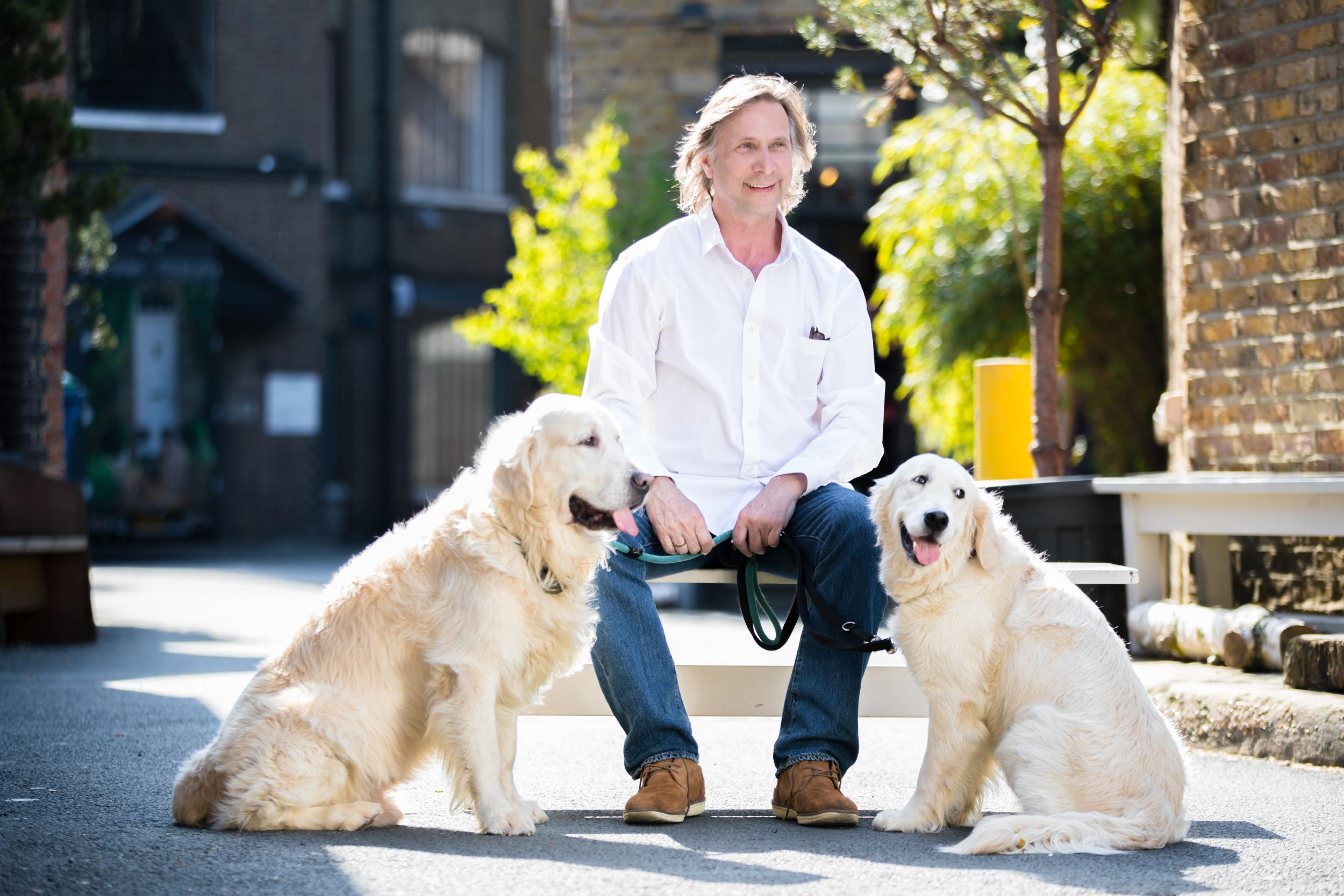A View from the Top: Jonathan Sattin, founder of Triyoga, on reinventing his life and career through yoga
Jonathan Sattin quit his law career to launch Triyoga in 2000 when yoga was an untouched market. What began a small start-up has now grown into a multi-studio operation offering hundreds of classes a week


The yoga industry is booming – there are now classes that even make use of laughing, sweltering temperatures... and goats.
In the UK, the pilates and yoga studio industry is worth an estimated £812m, supporting more than 4,000 business and employing nearly 16,000 people, according to a report last year.
But aficionados who practise daily might be surprised to hear that the man behind Triyoga – a studio chain that helped make yoga popular in the UK – is far from the poised yogi one might picture.
Jonathan Sattin quit his fast-paced law career (together with his daily 40 cigarettes and 14 coffees) to launch Triyoga in 2000, when yoga was an untouched market.
What began as a startup is now one of London’s leading destinations for yoga and pilates, with five studios across the capital and more than 750 classes per week.
Sattin had no initial plans to work in the wellbeing industry. “My father was a doctor and really wanted one of his three sons to follow in his footsteps,” he says.
“For years, I thought that’s what I was going to do too. But I ended up going to law school and eventually became a lawyer, setting up my own practice when I was 27.”
Looking for a better way to relax while studying, Sattin taught himself to meditate and the seeds for an altogether different life were sewn – not that he knew it at the time.
In 1985, one of his colleagues who thought he was a little “left of centre” suggested he try yoga and sent Sattin to a private class in northwest London. The experience turned out to be life-changing.
Sattin says: “It might sound clichéd but it’s one of these experiences that become more profound when you look back at them. At the time, I just realised instantly that I needed to change.
“I was a heavy smoker, I used to smoke 40 cigarettes a day and a drink about 14 cups of coffee with two sugars each. Within three months of practising I quit all of that.”
“It wasn’t that I suddenly gave up practising law, shaved my head and wore orange robes, but it was a catalyst for change. It encouraged me to do better.”
After 18 years of practising law he decided he had enough in 1996. Sattin agreed to a year’s notice, which gave him time to think about his next steps.
He says: “I was involved in the set up of Yo! Sushi and Protocol Multimedia Talent Agency. I was talking to some friends in Los Angeles, who said, ‘Why don’t you do what you love?’ and I realised yoga was what I was the most interested in.”
He travelled to the US to see how studios like YogaWorks in Los Angeles and Jivamukti yoga in New York operated. “The aim was to see what they were doing wrong and what I could learn from their mistakes,” Sattin says.
“Once I got the concept, I was very passionate about doing it and when you have that passion, people want you to succeed,” he adds.
Sattin used his network to fund the company and managed to raise £500,000. In 2000, with the help of a company board, some of whose members he found while walking his golden retriever in Regent’s Park, the first Triyoga studio in Primrose Hill was born.
Early investors included David Svendsen, who was then chair of Microsoft, while Simon Low joined the company to be director of yoga, a role he kept until 2002.
If you are a little shy about stepping inside this impressive mecca for yogis, you shouldn’t be. The whole concept was to create a place for all.
Sattin says: “From the beginning, the idea was to create a place where anyone could practice yoga. It had to be authentic and we also wanted to have a wide range of classes. I knew from my own experience that people want different things at different times.
600,000
The number of people who attend Triyoga classes each year
“Sometimes you might want something dynamic and sometimes you might want something restorative. We wanted to help our customers to find the type of practice that was appropriate for them.”
With its proximity to the London homes of Sadie Frost and Gwyneth Paltrow, who have both attended classes there, the Primrose Hill centre quickly become a byword for glamour – an image that Sattin is visibly uncomfortable with.
He says: “When we first opened, our studio Primrose Hill wasn’t quite as cool and glamorous as it is now. It had the feeling of a village and it was quite awkward to get there. It was interesting as an area. We never sought to attract celebrities, our aim was to give time and space to practice to anyone that comes through our doors.”
For the first full year, the company’s turnover was £393,000, and in 2017 this jumped to an impressive £6.2m. More than 600,000 people attend Triyoga classes every year and in 2015 it opened a teacher-training academy.
A branch opened in Covent Garden in 2003, followed by Soho in 2005, and another two studios in Shoreditch and Ealing opened their doors in 2017.
Of course, there were also some obstacles. Triyoga was forced out of its coveted location in Primrose Hill after losing a three-year battle against a development firm. Fortunately, Sattin promptly found an alternative venue in Camden in an old piano factory in Jamestown Road – a short walk away from its original location.
Each studio now has a café and a shop. The company also offers teacher training, retreats and holidays.
Sattin says: “As we’ve expanded, we’ve tried to get better, and improve our service and our offering. We always had changing rooms and showers – which was quite unusual at the time. But we’ve added cafés, shops and more treatments.
“Essentially, we wanted our customers to have a comfy space where they wanted to stay and hangout. We wanted them to feel like they were part of something.”
The market has changed considerably since Triyoga first opened its doors nearly 20 years ago. Competition might be more brutal than ever – but Sattin says the quality of the teaching at Triyoga is what makes them different from rivals.
He says: “We are passionate with the quality of our teaching and our treatments. We now have 122 teachers, not including those who come for guest’s lessons.
“We look at how qualified they are, but also if they teach the way that is right for us. As a basic rule our teachers need to have a minimum of five years’ experience. Each one goes through a thorough interview process and also teaches a class to the team and to our clients.”
The company may not have embraced goat yoga, but it has been quick to evolve with the times – last year, Triyoga spearheaded an initiative for Consent Cards, the first of its kind, in response to the #MeToo movement.
Sattin explains: “In yoga, some of our students may wish to be corrected, but others just prefer not to be touched.
“These allow all students to put a card on their mat, so if they don’t want to be adjusted, the teacher knows without them having to say anything.”
The company hosts a triyoga podcast, which Sattin says is all about confronting issues in the wellness world head-on. This include debates about yoga practices in a #MeToo era and the complex relationship between contemporary yoga and eating disorders.
Perhaps it is down to the calming effect of yoga, but Sattin is refreshingly humble when talking about the centre’s success. When asked about oversea expansion plans, he says: “We don’t have plans to expand outside of the UK for now. I want to keep our values and continue investing in the right people, look at how we can improve our service and provide even better care for our clients.”
Join our commenting forum
Join thought-provoking conversations, follow other Independent readers and see their replies
Comments